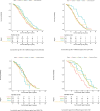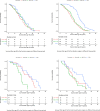Survival and longevity of European rulers: geographical influences and exploring potential factors, including the Mediterranean diet - a historical analysis from 1354 to the twentieth century
- PMID: 38012365
- PMCID: PMC11226567
- DOI: 10.1007/s11357-023-00957-5
Survival and longevity of European rulers: geographical influences and exploring potential factors, including the Mediterranean diet - a historical analysis from 1354 to the twentieth century
Abstract
Significant regional variability in lifespan in Europe is influenced by environmental factors and lifestyle behaviors, including diet. This study investigates the impact of geographical region on the lifespan of European rulers spanning from the fourteenth century to the present day. By analyzing historical records and literature, we aim to identify region-specific dietary patterns and lifestyle factors that may have contributed to longer lifespans among rulers. The hypothesis to be tested is that rulers from Southern European countries, where the traditional Mediterranean diet is consumed by the local people, may exhibit longer lifespans compared to rulers from other regions, due to the well-documented health benefits associated with this dietary pattern. We extracted comprehensive information for each ruler, encompassing their sex, birth and death dates, age, age of enthronement, duration of rulership, country, and cause of death (natural vs. non-natural). To determine their nationality, we coded rulers based on their hypothetical present-day residence (2023). Utilizing the EuroVoc Geographical classification, we categorized the countries into four regions: Northern, Western, Southern, Central and Eastern Europe. While Cox regression models did not find significant differences in survival rates among regions, further analysis stratified by time periods revealed intriguing trends. Contrary to our initial predictions, the Northern region displayed better survival rates compared to the Southern region between 1354 and 1499, whereas survival rates were similar across regions from 1500 to 1749. However, after 1750, all regions, except the Southern region, exhibited significantly improved survival rates, suggesting advancements in healthcare and lifestyle factors. These findings underscore the dynamic influence of both region and time period on health and longevity. Interestingly, despite the prevalence of the Mediterranean diet in the Southern region of Europe, rulers from this region did not demonstrate longer lifespans compared to their counterparts in other regions. This suggests that additional lifestyle factors may have played a more prominent role in their longevity. In conclusion, our study sheds light on the intricate relationship between region, time period, and lifespan among European rulers. Although the Mediterranean diet is often associated with health benefits, our findings indicate that it alone may not account for differences in ruler longevity across regions. Further research is warranted to explore the impact of other lifestyle factors on the health and lifespan of European rulers throughout history.
Keywords: Aging; Healthy aging; Historic; Kings; Longevity; MedDiet; Mediterranean diet; Rulers.
© 2023. The Author(s).
Conflict of interest statement
The authors declare that the research was conducted in the absence of any commercial or financial relationships that could be construed as a potential conflict of interest. Dr. Adam G. Tabak serves as Associate Editor for GeroScience. Dr. Zoltan Ungvari serves as Editor-in-Chief for GeroScience.
Figures





Similar articles
-
Between Lake Baikal and the Baltic Sea: genomic history of the gateway to Europe.BMC Genet. 2017 Dec 28;18(Suppl 1):110. doi: 10.1186/s12863-017-0578-3. BMC Genet. 2017. PMID: 29297395 Free PMC article.
-
European materia medica in historical texts: longevity of a tradition and implications for future use.J Ethnopharmacol. 2010 Oct 28;132(1):28-47. doi: 10.1016/j.jep.2010.05.035. Epub 2010 Jun 16. J Ethnopharmacol. 2010. PMID: 20561577 Free PMC article.
-
Intellectual maturity and longevity: late-blooming composers and writers live longer than child prodigies.Aging (Albany NY). 2017 May 30;9(5):1433-1439. doi: 10.18632/aging.101245. Aging (Albany NY). 2017. PMID: 28562321 Free PMC article.
-
An ethnopharmacological and historical analysis of "Dictamnus", a European traditional herbal medicine.J Ethnopharmacol. 2015 Dec 4;175:390-406. doi: 10.1016/j.jep.2015.09.011. Epub 2015 Sep 24. J Ethnopharmacol. 2015. PMID: 26387739 Review.
-
Impact of Mediterranean Diet on Chronic Non-Communicable Diseases and Longevity.Nutrients. 2021 Jun 12;13(6):2028. doi: 10.3390/nu13062028. Nutrients. 2021. PMID: 34204683 Free PMC article. Review.
Cited by
-
Improving Cognitive Function with Nutritional Supplements in Aging: A Comprehensive Narrative Review of Clinical Studies Investigating the Effects of Vitamins, Minerals, Antioxidants, and Other Dietary Supplements.Nutrients. 2023 Dec 15;15(24):5116. doi: 10.3390/nu15245116. Nutrients. 2023. PMID: 38140375 Free PMC article. Review.
References
-
- Pes GM, et al. Diet and longevity in the blue zones: a set-and-forget issue? Maturitas. 2022;164:31–7. 10.1016/j.maturitas.2022.06.004. - PubMed
-
- Eurostat. Life expectancy by age and sex in 2020. https://ec.europa.eu/eurostat/databrowser/bookmark/e3f138df-5165-4db9-80.... Accessed 12 Apr 2023.
-
- Bor J, Cohen GH, Galea S. Population health in an era of rising income inequality: USA, 1980-2015. Lancet. 2017;389(10077):1475–90. 10.1016/s0140-6736(17)30571-8. - PubMed
-
- Guasch-Ferré M, Willett WC. The Mediterranean diet and health: a comprehensive overview. J Intern Med. 2021;290(3):549–66. 10.1111/joim.13333. - PubMed
Publication types
MeSH terms
Grants and funding
- R01AG055395/AG/NIA NIH HHS/United States
- RF1AG072295/AG/NIA NIH HHS/United States
- K01AG073614/AG/NIA NIH HHS/United States
- TKP2021-NKTA-47/Innovációs és Technológiai Minisztérium
- R01 CA255840/CA/NCI NIH HHS/United States
- R01CA255840/CA/NCI NIH HHS/United States
- K01 AG073614/AG/NIA NIH HHS/United States
- R01 NS100782/NS/NINDS NIH HHS/United States
- R01AG068295/AG/NIA NIH HHS/United States
- R01NS100782/NS/NINDS NIH HHS/United States
- R01 AG070915/AG/NIA NIH HHS/United States
- R01 AG068295/AG/NIA NIH HHS/United States
- R01 AG055395/AG/NIA NIH HHS/United States
- RF1 AG072295/AG/NIA NIH HHS/United States
LinkOut - more resources
Full Text Sources

